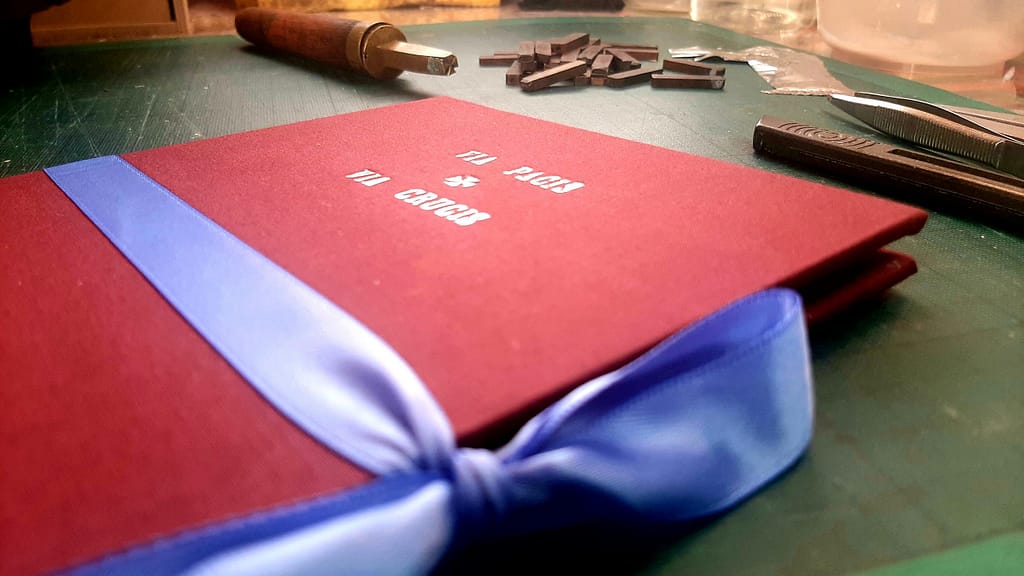I dealt with mould staining, 80 year old rusty staples, and created a unique case to protect a family heirloom, written by an intriguing priest
Some of the books that end up on the bench can only be described as ‘books’ if we’re being generous with that term. This is one of them, and it’s a personal project. This little booklet, called Via Pacis Via Crucis, belonged to my Great Aunty Ayleen but must have been kept by my Grandmother (her sister) because it was found by my Mum when Gran died. Ayleen’s son Adam has a milestone birthday this year, so Mum thought it would be a nice gesture to do some repair and conservation work on it, make it presentable, and send it to him over in America. A little detective work by my parents revealed that Aunty Ayleen must have been 14 when she received this. Judging from the time of year, and that her school is named, this must have been a leaving school present, because that’s the age you left school back in the day!
The author of the work was Fr. William O’Grady, a priest in Yorkshire. He was moderately well known as an intellectual, a poet, and even a cartoonist. Some of his pictures are on the parish website – my favourite is the priest celebrating Christmas with 3 cigars on the go! This booklet was published by Laverty & Sons of Leeds, prolific publishers of liturgical and devotional works in the first half of the 20th Century, and I’m sure we’ll come across them again. They produced Via Pacis Via Crucis in 1941, and it is full of Fr. O’Grady’s war poetry, his own very moving Stations of the Cross, and prayers for peace from two different Popes. This was written around the time of the Blitz, so in a (by today’s sensibilities) very strongly worded foreword, he reminds his readers that ““For Christians, the way of peace is the way of the Cross”, hence the name of the booklet.
Like I said, this isn’t a ‘real’ book, so the cover is only a textured card. The title has been stamped into it using letterpress machinery. This means you can feel the texture of the letters on the inside of the cover (as you can see), but it’s also left a ‘shadow’ of the cover design on the title page. That was the least of my worries though – there’s noticeable dark grey mould staining on that title page, and the 80 year old staples are well rusted. Just like a plumber is honour-bound to dispose of lead, we bookbinders have to remove any steel we see, so the staples have to go!
Once the rusty staples were disposed of, I safely removed the cover and got to work on the title page. To deal with the mould, I used a specialist conservation pad. It contains a non-abrasive compound which absorbs the staining and can then be brushed away. This was slow and painstaking work, hunched over the title page and rubbing the pad over it in tiny circles. At first it didn’t look like it was doing much, but eventually, I saw that the compound was going grey, so I knew it must be doing something. Comparing it to the ‘before’ picture I took for this blog actually helped me while I was doing the work. You can see for yourself the difference it’s made. That done, I could get on with reattaching the pages to the cover, using a 5 hole pamphlet stitch and waxed linen thread – much nicer than staples!
Unfortunately, one of the staples had ripped through the card cover, which meant I couldn’t just sew the pages to it. Plus, even the conservation pad couldn’t touch the rust staining. So I hatched a scheme to solve two problems at once. By reinforcing the inside of the card with Calico (a starchy linen) I could cover the stains and give myself something solid to sew through. Of course, I then realised that stark white linen would be wholly out of place next to this old card stock, so I cast my mind back to school and dying paper with tea to make it look ‘ye olde’. Do you remember doing that? I did a few experiments and it worked a treat, so I decided I could do the same on the outside to cover the sewing. I can’t quite believe it worked as well as it did!
The sewing complete, it was time to create a design for a protective folder. These little booklets don’t sit easily on a shelf with the big books, which is why they end up in shoeboxes and the bottom of draws, where they get damp and mouldy like this one did. Something sturdy yet stylish was required to keep the delicate booklet safe, and to present this family heirloom in a worthy manner. It took me a while to figure out how best to execute it, but a portfolio-style enclosure, with an internal frame to hold the booklet in place seemed the best bet.
I was initially in two minds about adding a title to the portfolio cover, largely because setting individual brass type letters by hand is a time-consuming process! I realised it served a practical purpose, though. Without it, someone could pick it up upside-down, and the booklet could slide out – the opposite of what I was going for! Aesthetically, the cooler silver and pale blue (of the tooling and ribbon, respectively), provide a wonderful contrast with the warmer maroon of the soft, linen-rich bookcloth. I did allow myself a few moments’ contemplation on the fact that sometimes finding practical solutions can inspire creative touches.
By the time this post goes live, this family ‘relic’ will have arrived in the US, so “Happy Birthday, Adam!”. As a footnote to the blog, I’m incredibly pleased that the Calico was dyed so successfully with English Breakfast Tea. When my Gran first planned to visit Aunty Ayleen in America, she was told, as a matter of some urgency, to bring a tin of Quality Street and as many teabags as she could fit in her suitcase! The things the English do to survive when abroad, eh?
It’s kind of funny how these otherwise disposable items end up as treasured mementos and keepsakes. They’re never produced with that in mind, but it’s prefectly natural from a sacramental point-of-view, since they literally put us in touch with our loved ones, the wider Church, world history…the whole lot! Is there something like this, half-forgotten and mouldering in a box or wardrobe somewhere, with all the broken Rosary beads (I know you have them because I do too!)? If so, don’t write it off – I’m sure there’s something I can do to bring back out into the light, either for yourself or as a thoughtful gift. Get in touch via the form on the Contact Us page, and I’ll be happy to consult with you about what can be done.













